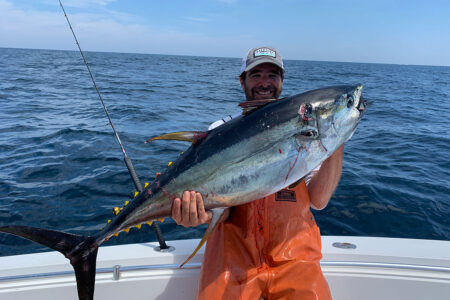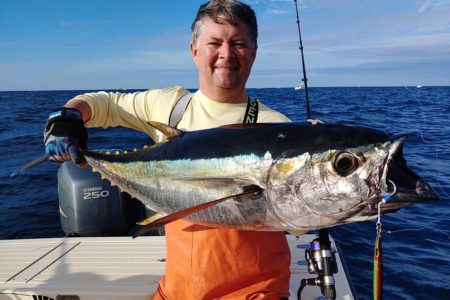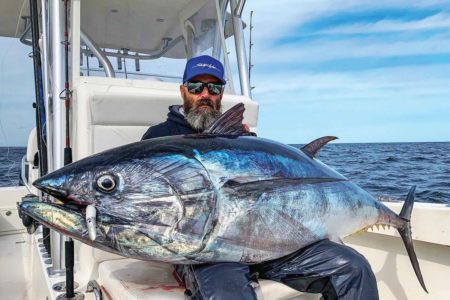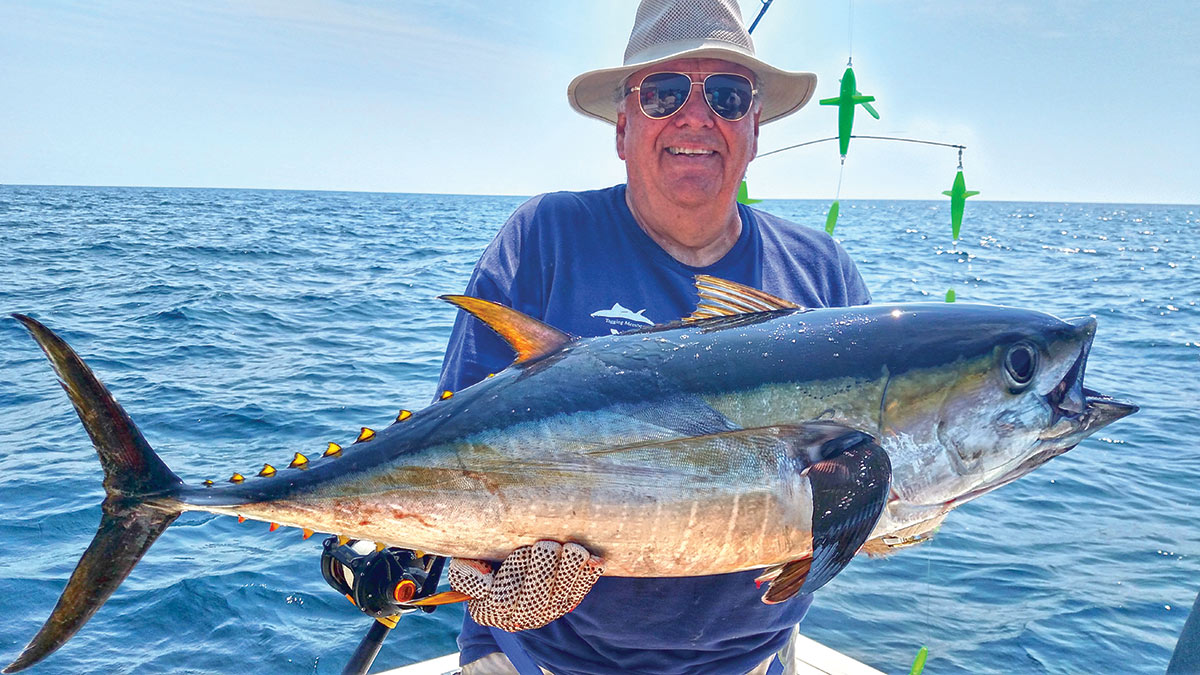
A little commotion goes a long way in achieving big game success.
Trolling for bluefin or yellowfin tuna has always been a very effective method for putting fish in the box. The size of your boat and the skill of the angler usually determines the number of rods that one will put back in your spread. The artificials you pull create a commotion behind the boat that mimics a pod of bait that gets the attention of the tuna.
If you were to use nothing but the traditional artificials that have been around forever like cedar plugs, feathers, Zukers, and jets, you would catch plenty of tuna; this is how it has been done for decades. But today the industry has taken an innovative turn with new designs and new styles of tackle that have taken the market by storm. Taking center stage are changes to spreader bars and daisy chains.
Trolling Revolutions
Spreader bars are being designed with multiple rows of birds sometimes with as many as nine birds on a bar. And chains are now being designed with upwards of five to eight birds ahead of a 6- to 9-inch machine stinger. A new type of bar called a side tracker or wide tracker has also emerged that has a single planar or keel under the center bird that causes the bar to plane out to the side of your spread allowing it to run to the outside of your wake. The idea behind all these designs is to create more splash or commotion to attract the tuna. And if you speak to the anglers that have been using them the consensus is that it’s working and working well.
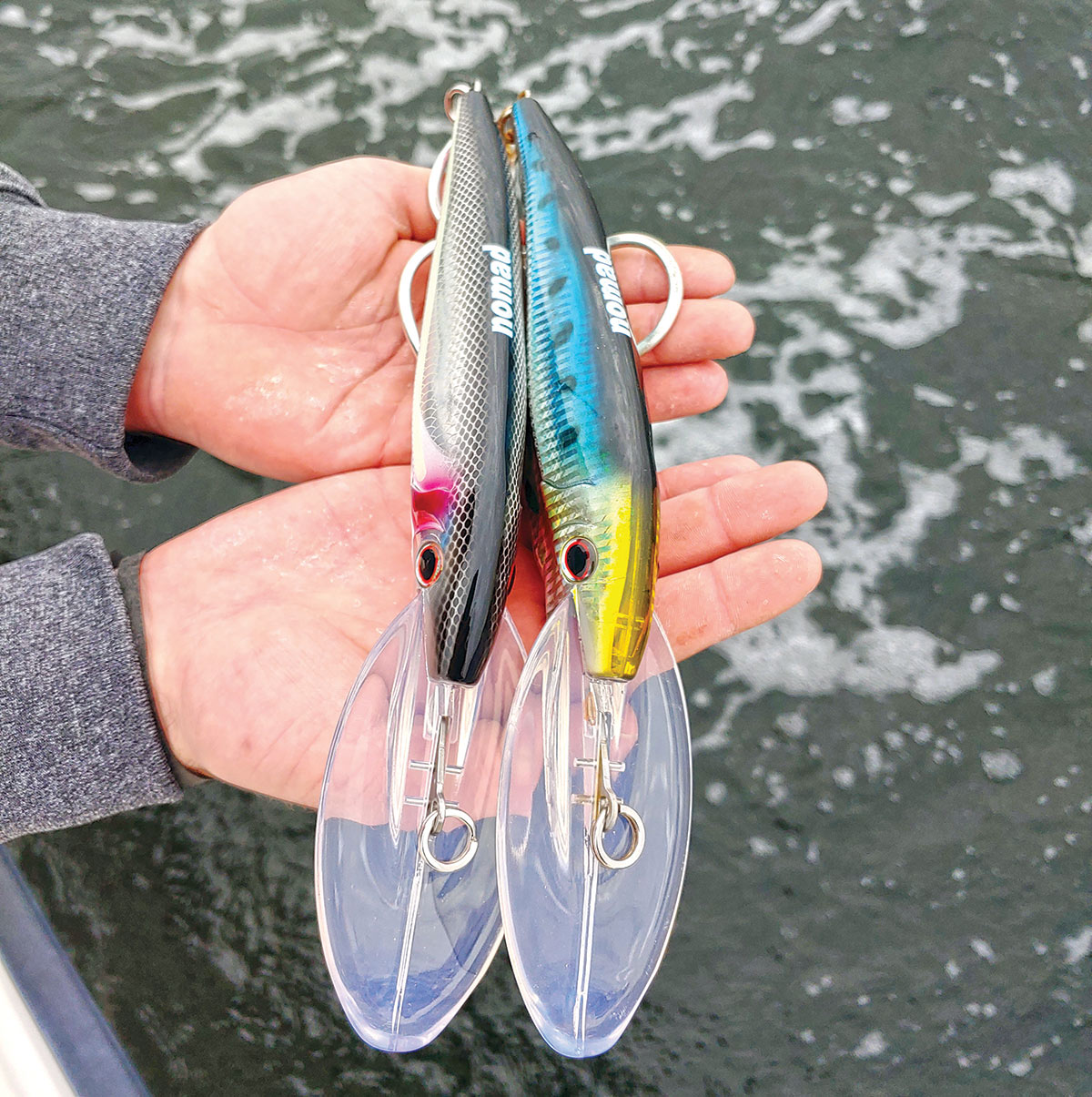
I like to look at why these new innovations are effective so let’s try to think like a tuna for a minute. If you ask the question “What is your biggest and best lure in your spread,” the answer would be “it’s your boat.” What draws the tuna into your spread is twofold. One is vibration that your engine makes in the water. Tuna, like other fish, have a highly sophisticated lateral line, which is a system of tactile sense organs that runs along the side of their body that detects vibrations, movements, and pressure changes in the surrounding water. The lateral line system enables the tuna to locate and follow the vibrations produced by fleeing prey. Studies have shown that most species of bony fishes probably detect prey by sound and have shown that fish can exhibit a receptive specificity for particular frequencies of stimulation.
So one would have to think that the vibration from your engine gets the attention of the tuna and they will home in on it. Since every boat engine is different and will put out a slightly different vibrational frequency some boats on some days just seem to catch better than others. A good example of this is when your buddy is crushing fish trolling at 6.5 knots and you match the same speed and are pulling exactly the same gear but you don’t get bit like him. This has to make you wonder what the difference is.
For this reason I like to pay attention to my engine RPMs that is getting me bit. I like to call this engine vibration the sweet spot. The frequency vibrations perceived by most fish is in the low frequency spectrum range from 1 to 200 Hertz (or Hz, being a unit of measure that means vibrations per second). So if you’re trolling at an engine revolution per minute (RPM) this would produce a vibration of 33.3 Hz which is in the fish’s perception.
Visually Appealing
Besides vibration you also have the visual sensation and commotion caused by your boat and prop wash that the tuna sees when they look up to the surface. Now a tuna doesn’t recognize what a boat is nor do I think it would ever remember what a boat looks like after it sees one. But the boat’s dark underside or shadow most likely resembles a tightly balled cloud of bait. And your prop wash is perceived as the tail end of the pod most likely in a frenzy as prey are attacking it. This is something tuna are familiar seeing and is how they are programmed. It looks natural to them and rings the dinner bell for them. So up they come into your spread and right up close to the boat to cash in on the action. Think about it, if tuna were afraid or spooked by your boat you would never catch one on a cedar plug as the boat would scare them away.
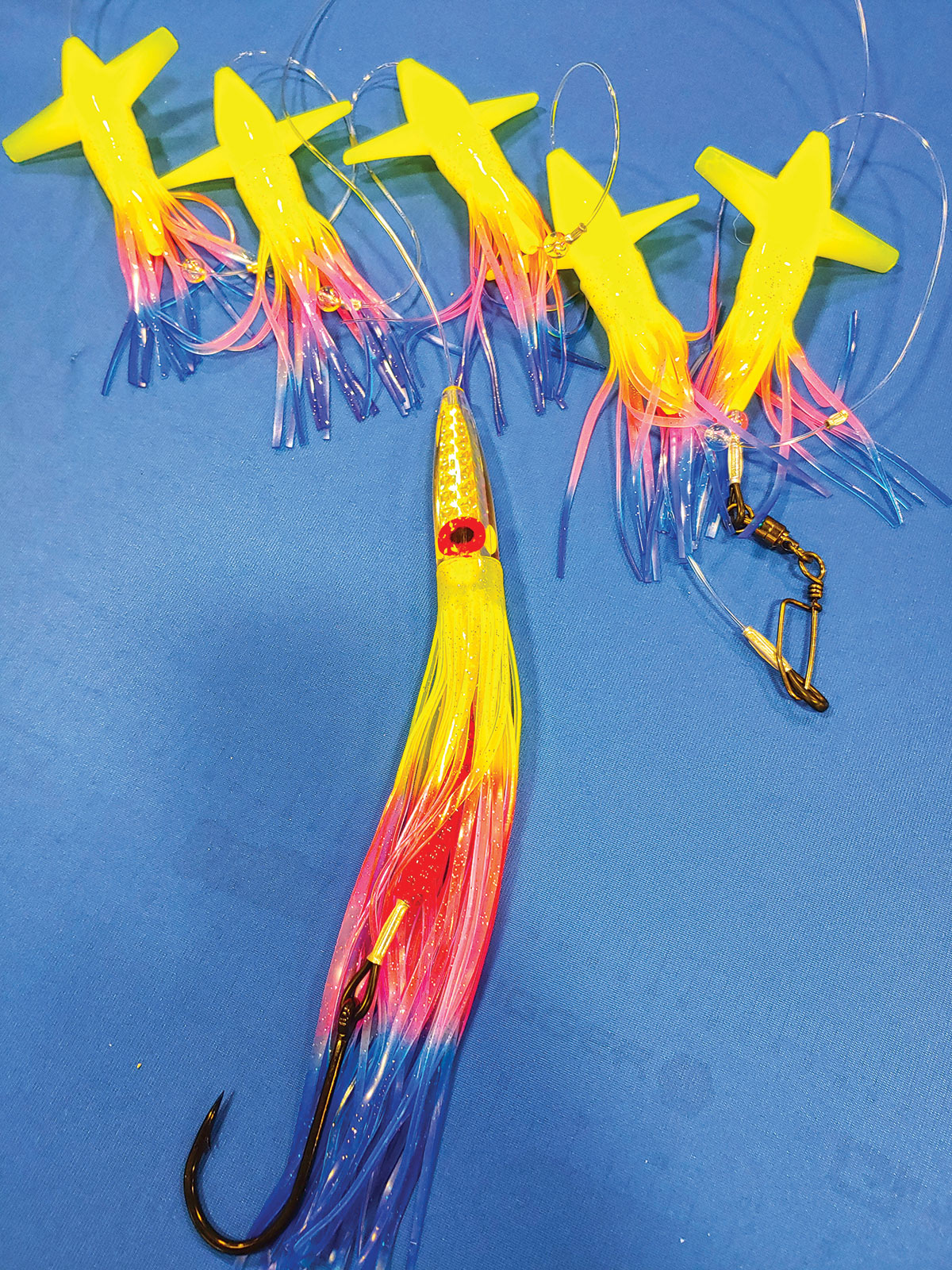
Side trackers are the newest innovation in trolling and have taken the tuna industry by storm in the last two years. First introduced to the market in 2017 as Wide Trackers by Sterling Tackle these spreader bars are designed with a planer or keel that is either glued or pinned to the bottom of the center bird that makes the bar plane out to the side when pulled behind the boat. This causes the bar to track outside of your normal spread and work in calm water. They are ideal for small boaters to use if you don’t have outriggers to widen your spread. The side trackers can be trolled right from the rod tip when the rod is placed in the gunnel.
Their effectiveness can’t be overlooked as anyone trolling them can attest to how productive they are. So what is it about the side tracker that has made it so productive? My thoughts are the tuna are attracted into your spread by your boat and are enticed into biting your artificials but for some reason do not. They then slide out and think “boy did I ever make a mistake I had a chance to eat and I didn’t.” And then they slide right into the side trackers and say “I’m not going to make the same mistake twice,” and bite.
I like to use side trackers made by Chatterlures as I personally feel they are the best built on the market. The planar is pinned and not glued and is multidirectional so it can be rotated to run either on the port or starboard side of your boat.
Another innovation that is also quickly catching on is to troll deep diving plugs for tuna. The problem up until now has been to find plugs that can be trolled at the faster 6 or 7 knots with your bars and not pop out of the water. Beefing up deep-diving striped bass plugs with tuna split rings and trebles can work when trolled at 3 to 4 knots and can be trolled along with Joe Shute’s and ballyhoo. But these plugs don’t run right at the higher speeds.
One new entry on the market is the Nomad Design DTX deep diving minnow, which can be trolled up to 11 knots. The 6.5-inch and 8-inch plug will dive to 30 and 40 feet respectively. There is also no need to beef up any of the hardware as they are tuna ready with heavy duty split rings and BKK hooks.
Other high-speed trolling entries in the market include the Rapala X-Rap Magnums in 15, 20, 30 and 40 sizes, which will run from 15 to 30 feet deep at speeds of up to 12 to 13 knots, while the Yo-Zuri Bonita in 6-3/4- and 8-1/4-inch sizes can be trolled upwards of 15 knots making them ideal for wahoo as well.
| HMS PERMIT INFO |
|---|
|
Vessel owners/operators who recreationally fish for or retain regulated Atlantic tuna including bluefin, yellowfin, bigeye, albacore, and skipjack, as well as sharks, swordfish, and billfish in Atlantic Federal waters (including the Gulf of Mexico and the Caribbean Sea) must obtain an HMS Angling category permit at a cost of $26. As for the age-old question, “May I fish for Atlantic tunas without a vessel (e.g., from an oil rig or from shore),” that is answered directly at the hmspermits.noaa.gov permit site which reads, “only permitted vessels may fish for Atlantic bluefin, bigeye, albacore, yellowfin, and skipjack tunas in the Atlantic, Gulf of Mexico, and the Caribbean. If one of these species is caught incidentally during fishing activities from shore or from an oil rig, it must be released immediately.” Contact National Marine Fisheries Service at 888-872-8862 or purchase your HMS Angling category permit online at hmspermits.noaa.gov permit. |
